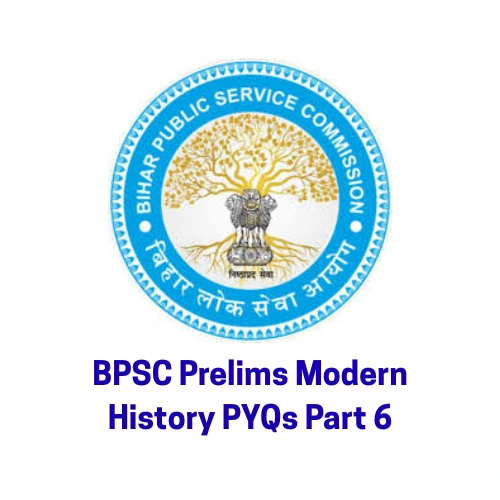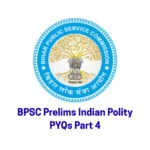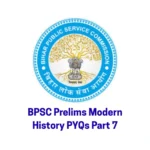Modern History holds major weight in BPSC Prelims, covering the period from European entry to Independence. Key focus areas include in BPSC Prelims Modern History PYQs Part 6:
- Arrival of Europeans and British dominance.
- Policies of British rule and their impact.
- Reform movements and social awakening.
- Tribal and peasant revolts.
- Revolt of 1857 (Kunwar Singh in Bihar).
- Nationalist movements—Moderates, Extremists, Gandhian phase.
- Revolutionaries, INA, and Subhas Bose.
- Bihar’s role: Champaran Satyagraha, Quit India.
BPSC Prelims Modern History PYQs Part 6
When was Punjab Land Alienation Act passed?
(a) 1850
(c) 1900
(b) 1895
(d) 1905
(e) None of the above/More than one of the above
Ans. (c)
Who was the ruler of India when the English East India company was formed?
(a) Aurangzeb
(c) Jahangir
(b) Akbar
(d) Humayun
(e) None of the above/More than one of the above
Ans. (b)
Which of the following Princely states was not annexed by the British?
(a) Sind
(c) Awadh
(b) Gwalior
(d) Satara
(e) None of the above/More than one of the above
Ans. (b)
What was the ultimate goal of Gandhiji’s Salt Satyagraha?
(a) Repeal of Salt Laws
(b) Curtailment of the government’s power.
(c) Economic Relief to the Common People
(d) Poorrna Swaraj for India
(e) None of the above/More than one of the above
Ans. (e)
The Moplah Rebellion of 1921 broke out in
(a) Assam
(c) Punjab
(b) Kerala
(d) Bengal
(e) None of the above/More than one of the above
Ans. (b)
BPSC Prelims Modern History PYQs Part 6
The Swadeshi Movement took place in India during
(a) The Champaran Satyagraha of Gandhiji
(b) The Anti-Bengal Partition Agitation
(c) The Protest against the Rowlatt Act
(d) The Non Cooperation Movement
(e) None of the above/More than one of the above
Ans. (b)
“The Muslims, if contented and satisfied, would become the greatest bulwark of British power in India”. Who wrote it?
(a) Herbert Risley
(c) W.W Hunter
(b) Lord Lytton
(d) HN Brailsford
(e) None of the above/More than one of the above
Ans. (c)
Who was selected as the First President of All India Kisan Sabha at Lucknow in 1936?
(a) NG Ranga
(b) EMS Namboodripad
(c) Swami Sahajananand Saraswati
(d) Acharya Narendra Dev
(e) None of the above/More than one of the above
Ans. (c)
In my belief, Congress is tottering to its fall and one of my great ambitions while in India is to assist it to a peaceful demise”. Who wrote it?
(a) Lord Lytton
(c) Lord Curzon
(b) Lord Dufferin
(d) Lord Minto
(e) None of the above/More than one of the above
Ans. (c)
Sir Michael O’Dwyer was shot dead on March 13, 1940 in London by
(a) Madan Lal Dhingra
(b) MPT Acharya
(c) VD Savarkar
(d) Udham Singh
(e) None of the above/More than one of the above
Ans. (d)
BPSC Modern History Questions
Who was the Prime Minister of England when the Montague-Chelmsford Act was passed in 1919?
(a) Lloyd George
(b) George Hamilton
(c) Sir Samuel Hoare
(d) Lord Salisbury
(e) None of the above/More than one of the above
Ans. (a)
Who is regarded as the “Mother of Indian Revolution”?
(a) Annie Besant
(b) Snehlata Wadekar
(c) Sarojini Naidu
(d) Madam Bhikhaji Rustam Cama
(e) None of the above/More than one of the above
Ans. (d)
Who became champion of socialism and wanted to overthrow of British rule, Princely states, Landlordism and Capitalism in 1933?
(a) Rajendra Prasad
(b) Jawaharlal Nehru
(c) Bhulabhai Desai
(d) Sardar Patel
(e) None of the above/More than one of the above
Ans. (b)
The Chittagong Armoury Raid had been planned by
(a) Surya Sen
(c) Vidhan Ghosh
(b) Chandan Dutta
(d) Jatin Das
(e) None of the above/More than one of the above
Ans. (a)
Which journal was not associated with the revolutionary activities?
(a) Sandhya
(c) Ghadar
(b) Yugantar
(d) Young India
(e) None of the above/More than one of the above
Ans. (d)
BPSC Prelims Modern History PYQs Part 6
First Indian elected to the British House of Commons was “Dadabhai Naoroji”, who contest on the ticket of
(a) Liberal Party
(b) Labour Party
(c) Conservative Party
(d) Communist Party
(e) None of the above/More than one of the above
Ans. (a)
Swaraj Party was formed following the failure of :-
(a) Non-Cooperation Movement
(b) Civil Disobedience Movement
(c) Rowlatt Bill Satyagraha
(d) Champaran Satyagraha
(e) None of the above/More than one of the above
Ans. (a)
Who organized the “Khudai Khidmatgar” in 1929?
(a) Abdul Ghaffar Khan
(b) Ali Brothers
(c) Ansari Brothers
(d) Maulana Abul Kalam Azad
(e) None of the above/More than one of the above
Ans. (a)
The Cabinet Mission came to India in
(a) February, 1942
(c) April, 1942
(b) March, 1942
(d) May, 1942
(e) None of the above/More than one of the above
Ans. (e)
The precursor of Indian National Congress was
(a) British Indian Association
(b) Indian Association
(c) Indian National Union
(d) Indian League
(e) None of the above/More than one of the above
Ans. (b)
BPSC Modern History Questions
Who is known as “Father of Dyarchy”?
(a) Lord Clive
(c) Hector Munro
(b) Lord Macaulay
(d) Sir Lionel Curtis
(e) None of the above/More than one of the above
Ans. (d)
Akhil Bhartiya Kisan Congress was founded in
(a) 1936 AD
(b) 1939 AD
(c) 1942 AD
(d) 1945 AD
(e) None of the above/More than one of the above
Ans. (a)
In which of the following years, Surendra Nath Banerjee was eliminated from Indian Civil Services?
(a) 1874 AD
(b) 1877 AD
(c) 1885 AD
(d) 1892 AD
(e) None of the above/More than one of the above
Ans. (a)
Which among the following Viceroy Period, the title of Rai Bahadur and Khan Bahadur were began to be conferred to Indians?
(a) Lord Rippon
(b) Lord Lytton
(c) Lord Mayo
(d) Lord Dufferin
(e) None of the above/More than one of the above
Ans. (b)
In which year was the regulating Act passed?
(a) 1757 AD
(c) 1773 AD
(b) 1765 AD
(d) 1793 AD
Ans. (c)
BPSC Prelims Modern History PYQs Part 6
Who was the Governor General of India in 1857?
(a) Lord Wellesley
(b) Lord Dalhousie
(c) Lord Canning
(d) Lord Minto
Ans. (c)
After which incident Mahatma Gandhi had called “Non Cooperation Movement” as his Himalayan Blunder?
(a) Chauri Chaura
(b) Kheda Satyagraha
(c) Nagpur Satyagraha
(d) Rajkot Satyagraha
Ans. (a)
Which movement started after the “Partition of Bengal”?
(a) Civil Disobedience Movement
(b) Swadeshi Movement
(c) Quit India Movement
(d) Non Cooperation Movement
Ans. (b)
Who was the first Indian woman President of the Indian National Congress?
(a) Mrs Annie Besant
(b) Sucheta Kriplani
(c) Sarojini Naidu
(d) Indira Gandhi.
Ans. (c)
Where did Madam Cama hoist the first tricolour flag in 1907?
(a) London
(c) Moscow
(b) Paris
(d) Stuttgart.
Ans. (d)
BPSC Modern History Questions
Who founded the “Pagal Panth”?
(a) Bullel Shah
(c) Yaduvendra
(b) Karam Shah
(d) Swami Sahajananda
Ans. (b)
Who were the Faraizis?
(a) Followers of Haji Shariatullah
(b) Followers of Dadu
(c) Followers of the Arya Samaj
(d) Followers of the Muslim League
Ans. (a)
The correct geographical location for the Ramosi Uprising was
(a) Western India
(c) Eastern India
(b) Eastern Ghats
(d) Western Ghats
Ans. (a)
The Waghera Uprising happened in
(a) Surat
(c) Calicut
(b) Poona
(d) Baroda
Ans. (d)
In order to control the media in India, Acts were passed in
(a) 1835, 1867, 1878, 1908
(b) 1854, 1864, 1872, 1910
(c) 1854, 1872, 1908, 1910
(d) 1867, 1908, 1910, 1919
Ans. (a)
BPSC Prelims Modern History PYQs Part 6
The process of split in the Congress in the early years of the twentieth century began over
(a) Strategies of the Congress Movement.
(b) Objectives of the Congress Movement
(c) Participation of the people in the Congress movement
(d) All of the above
Ans. (d)
“New Lamps for Old” was a series of articles [1893- 94] that criticized the Congress for being out of touch with “proletariat. Who was the author of these articles?
(a) Aurobindo Ghose
(c) G.K Gokhale
(b) A.O Hume.
(d) B.G Tilak
Ans. (a)
The Nehru report was drafted by a committee headed by and the subject was
(a) Motilal Nehru and Jawaharlal Nehru, India’s relationship with the British empire.
(b) Jawaharlal Nehru, Local Self-government in India
(c) Motilal Nehru, Constitutional Arrangements in India
(d) Jwaharlal Nehru: Constitutional Arrangements in India.
Ans. (c)
What was common relation between Katherine Mayo, Aldous Huxley, Charles Andrews and William Digby?
(a) They wrote commentaries on the condition of India during the British rule.
(b) They were supporters of the Indian National Movement.
(c) They were opponents of the Indian National Movement
(d) They were friends of Mahatma Gandhi
Ans. (a)
Who penned the following lines? “Sarfaroshi ki tamanna ab hamare dil me hai, dekhna hai zor kitna baju-e-qatil me hai”.
(a) Ram Prasad Bismil
(b) Rajguru
(c) Bhagat Singh
(d) None of the above
Ans. (d)


